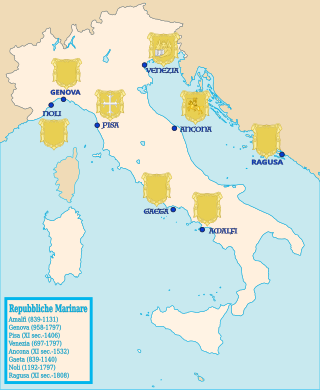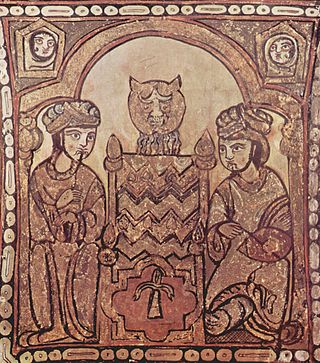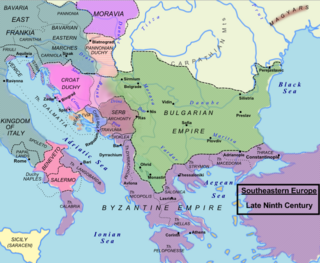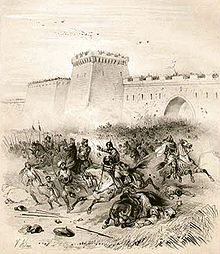The 830s decade ran from January 1, 830, to December 31, 839.
Year 876 (DCCCLXXVI) was a leap year starting on Sunday of the Julian calendar.

Saracen was a term used both in Greek and Latin writings between the 5th and 15th centuries to refer to the people who lived in and near what was designated by the Romans as Arabia Petraea and Arabia Deserta. The term's meaning evolved during its history of usage. During the Early Middle Ages, the term came to be associated with the tribes of Arabia.

Matera is a city and the capital of the Province of Matera in the region of Basilicata, in Southern Italy. With a history of continuous occupation dating back to the Palaeolithic, it is renowned for its rock-cut urban core, whose twin cliffside zones are known collectively as the Sassi.

Louis II, sometimes called the Younger, was the king of Italy and emperor of the Carolingian Empire from 844, co-ruling with his father Lothair I until 855, after which he ruled alone.

The history of Italy in the Middle Ages can be roughly defined as the time between the collapse of the Western Roman Empire and the Italian Renaissance. Late Antiquity in Italy lingered on into the 7th century under the Ostrogothic Kingdom and the Byzantine Empire under the Justinian dynasty, the Byzantine Papacy until the mid 8th century. The "Middle Ages" proper begin as the Byzantine Empire was weakening under the pressure of the Muslim conquests, and most of the Exarchate of Ravenna finally fell under Lombard rule in 751. From this period, former states that were part of the Exarchate and were not conquered by the Lombard Kingdom, such as the Duchy of Naples, became de facto independent states, having less and less interference from the Eastern Roman Empire.

The Duchy of Benevento was the southernmost Lombard duchy in the Italian Peninsula that was centred on Benevento, a city in Southern Italy. Lombard dukes ruled Benevento from 571 to 1077, when it was conquered by the Normans for four years before it was given to the Pope. Being cut off from the rest of the Lombard possessions by the papal Duchy of Rome, Benevento was practically independent from the start. Only during the reigns of Grimoald and the kings from Liutprand on was the duchy closely tied to the Kingdom of the Lombards. After the fall of the kingdom in 774, the duchy became the sole Lombard territory which continued to exist as a rump state, maintaining its de facto independence for nearly 300 years, although it was divided after 849. Benevento dwindled in size in the early 11th century, and was completely captured by the Norman Robert Guiscard in 1053.

The Catepanateof Italy was a province of the Byzantine Empire from 965 until 1071. At its greatest extent, it comprised mainland Italy south of a line drawn from Monte Gargano to the Gulf of Salerno. North of that line, Amalfi and Naples also maintained allegiance to Constantinople through the catepan. The Italian region of Capitanata derives its name from katepanikion.

Longobardia was a Byzantine term for the territories controlled by the Lombards in the Italian Peninsula. In the ninth and tenth centuries, it was also the name of a Byzantine military-civilian province known as the Theme of Longobardia located in southeastern Italy.

Adelchis was the son of Radelchis I, Prince of Benevento, and successor of his brother Radelgar in 854.

The Principality of Capua was a Lombard state centred on Capua in Southern Italy. Towards the end of the 10th century the Principality reached its apogee, occupying most of the Terra di Lavoro area. It was originally a gastaldate, then a county, within the principality of Salerno.
Lambert I was the duke and margrave of Spoleto on two occasions, first from 859 to 871 and then from 876 to his death.

The history of Islam in Sicily and southern Italy began with the first Arab settlement in Sicily, at Mazara, which was captured in 827. The subsequent rule of Sicily and Malta started in the 10th century. The Emirate of Sicily lasted from 831 until 1061, and controlled the whole island by 902. Though Sicily was the primary Muslim stronghold in Italy, some temporary footholds, the most substantial of which was the port city of Bari, were established on the mainland peninsula, especially in mainland southern Italy, though Muslim raids, mainly those of Muhammad I ibn al-Aghlab, reached as far north as Naples, Rome and the northern region of Piedmont. The Arab raids were part of a larger struggle for power in Italy and Europe, with Christian Byzantine, Frankish, Norman and local Italian forces also competing for control. Arabs were sometimes sought as allies by various Christian factions against other factions.

The Muslim conquest of Sicily began in June 827 and lasted until 902, when the last major Byzantine stronghold on the island, Taormina, fell. Isolated fortresses remained in Byzantine hands until 965, but the island was henceforth under Muslim rule until conquered in turn by the Normans in the 11th century.

The Norman conquest of southern Italy lasted from 999 to 1194, involving many battles and independent conquerors.
The Emirate of Bari was a short-lived Islamic state in Apulia, in what is now Italy, ruled by non-Arabs, probably Berbers and Black Africans. Controlled from the South Italian city of Bari, it was established about 847 when the region was taken from the Byzantine Empire, but fell in 871 to the army of the Carolingian emperor Louis II.

The siege of Ragusa by the Aghlabids of Ifriqiya lasted for fifteen months, beginning in 866 until the lifting of the siege at the approach of a Byzantine fleet in 868. The failure of the siege and the re-appearance of the Byzantines in the region of Dalmatia signalled the beginning of new aggressive western policy by the new Byzantine emperor, Basil I. Its immediate effects were the re-establishment of Byzantine authority there in the form of the Theme of Dalmatia, and the beginning of the Christianization of the Slavs of the western Balkans, but within a few years it led to renewed Byzantine involvement and presence in southern Italy as well.
The Rythmus de captivitate Ludovici imperatoris is a short alphabetic acrostic poem in Middle Latin lamenting the capture of Louis II, King of Italy and Emperor of the Romans, on 15 August 871. The poem is preserved in a ninth-century manuscript, Veronensis XC (85).

The siege of Salerno was one of the campaigns of the Aghlabids in southern Italy during their conquest of Sicily. The Lombard city of Salerno had strong defences and, despite the use of stone-throwing artillery, the siege lasted a little over a year from its beginning in late 871 or early 872. Prince Guaifer of Salerno led the defence, but the siege was only lifted by the arrival of an army of Lombards and Franks under the Emperor Louis II.

The coinage of Adelchis, prince of Benevento, constitutes a special chapter in the Lombard coinage of Benevento and bears witness to the political changes that took place during his principality. The period in which Adelchis minted runs from 854, when he became prince of Benevento, to 878; his coinage is centered on the denier, a silver coinage that became widespread in Europe following Charlemagne's rise to power.














